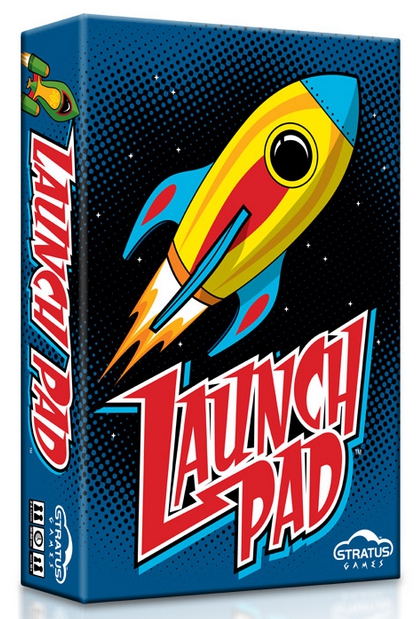
The Basics:
- For ages 7 and up (publisher suggests 10+)
- For 2 to 4 players
- From 30 minutes to 1 hour to complete
Geek Skills:
- Counting & Math
- Logical & Critical Decision Making
- Reading
- Strategy & Tactics
- Risk vs. Reward
- Hand/Resource Management
- Emotional Coping Skills
Learning Curve:
- Child – Moderate
- Adult – Easy
Theme & Narrative:
- It’s a race to Space! 3-2-1, BLAST OFF!
Endorsements:
- Gamer Geek approved!
- Parent Geek approved!
- Child Geek approved!
Overview
In Launch Pad, each player is attempting to build and prep as many rockets as they can before the rocket launch pad is ready to use. Players will need to manage their resources and build rockets that provide the most “bang” (please excuse the pun) to score points. To help the players, experts must be hired to assist in manufacturing, inspecting, and launching the rockets. Espionage is a constant threat as other rocket entrepreneurs attempt to sabotage and get the upper hand on this delightfully accessible and entertaining card game!
Launch Pad is comprised of 144 cards. The cards are divided into 8 types. These types are Rocket, Component, Expert, Bonus, Launch Pad, Action, Specialty, and Reference. Information on the cards is kept to a minimum but are descriptive enough so you will never need to reference the rule book. The rule book itself is easy to following, offers visual examples, and goes into more detail about each of the cards if the players need more information. The entire game is very well produced and manufactured. Stratus Games has once again put their money where it counts.
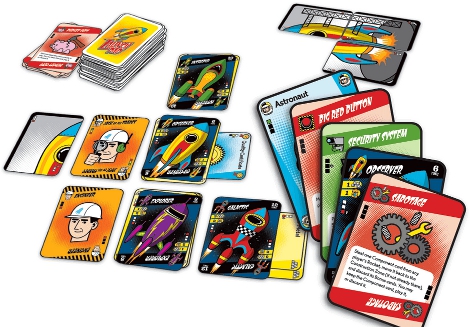
Outstanding quality and colorful cards make this game a joy to play!
Game Set Up
First, ensure that all players have enough space to play the game. This player space is referred to as a player’s “game zone”. For a card game, Launch Pad actually requires a surprisingly large amount of space.
To set up the game, remove the 4 Reference cards and the 4 Launch Pad cards. The Reference cards are double-sided and serve as an excellent visual example of each player’s game zone as well as an outstanding summary of the rule book. Give each player a Reference card.
The Launch Pad cards, once put together, look like a big rocket on a lauch pad. These cards serve to bring about the endgame and final scoring, but for the game set up, they are removed for the moment.
Once the above cards are removed, thoroughly shuffle the deck. Deal, face-down, 6 cards to each player. The players should not show these cards to the other players.
Next, divide the remaining deck roughly in half and shuffle in the 4 Launch Pad cards on the bottom portion. Place the other half of the deck on top and place the deck, face-down, in the center of the play area where all the players can easily reach it. There should also be enough room next to the deck for a discard pile and the building of the Launch Pad cards.
Decide who should go first and get ready for fun. You are now ready to play, but before you do, we need to make a few things about the game clear.
The Player’s Game Zone
Each player has in front of them their game zone. This game zone is divided into a grid of sorts. In total four columns and three rows.
The three rows represent the 3 different stages of rocket development. Starting from the bottom and moving up, the first row is the Construction Zone where the players build their rockets. The second row is the Quality Control Zone where the players can attach Bonus cards to protect their rockets and possibly make them worth more points. The third row is the Launch Zone where the rockets are made ready for blast-off! Throughout the game, cards will shift up and down these rows or be removed altogether. The rows also determine the number of points a player earns when the game is over.
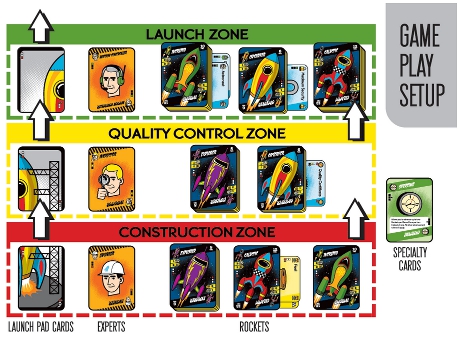
The player's game zone is where all the magic - and mayhem - happen in the game
The four columns are used to place the specific cards types. Starting from the left and moving right, the first column is reserved for Launch Pad cards. The second column is reserved for Expert cards. The third (and largest) column is where all the Rocket cards along with attached Component and Bonus cards are placed. The fourth and final row is where the Specialty card is placed.
Cards o’ Plenty
The Reference cards are pretty self-explanatory and do not require further explanation. The others require a brief summary before we go forward.
- Rocket cards: the rocket cards represent the different rockets that a player can build. The rockets are worth different points. Rockets are played in the Construction Zone and make their way upwards to the Launch Zone.
- Component cards: the two components needed to make a rocket are Metal and Fuel. These two Component card types are attached to rockets in the Construction Zone. The Rocket card must have all the Component cards attached, as needed by the rocket, before the player can advance their rocket to the next zone.
- Expert cards: the four experts are the Engineer who allows the player to move built rockets from the Construction Zone to the Quality Control Zone, the Inspector who allows the player to move their rocket from the Quality Control Zone to the Launch Zone, the Mission Controller who lets the rockets be scored when the launch pad is built, and the Jack of All Trades who can be played in any zone.
- Bonus cards: attached to rockets in the Quality Control or Launch Zone and provide additional protection from sabotage or points at the end of the game.
- Launch Pad cards: four cards that, once constructed, form the rocket launch pad. All Launch Pad cards start in the Construction Zone when played and advanced through the zones during each player’s turn. Once the Launch Pad is fully built, the endgame begins.
- Action cards: special cards that allow the player to take specific actions on their turn. These actions could include taking more cards on the player’s turn or sabotaging another player’s rocket. Once played, the Action card is discarded.
- Specialty cards: allows the player to take on a specialty that is always “in play” for as long as that Specialty card is active. Only one Specialty card can be used by the player at a time. If ever replaced or lost, they are discarded.
Let’s Build Rockets!
On a player’s turn, they perform the following specific steps in the order given:
- Advance all Launch Pad cards to the next zone. If the Launch Pad card is currently in the Launch Zone, move it to the area next to the deck and discard pile. Additional Launch Pad cards will be attached to it here.
- Optionally, advance one completed rocket to the next zone. Remember that the player cannot move a rocket to the next zone unless the rocket’s current zone has an expert and is fully built.
- Draw up to 6 cards. The player may draw the top card from the discard pile, but only once. The rest of the cards needed to complete a hand size of 6 cards must come from the draw pile. If a Launch Pad card is ever drawn, it is immediately put into play in the Construction Zone and another card is drawn to replace it.
- Play as many cards as possible and as wanted. If a player reduces their hand size to zero, they immediately draw back up to 6 cards and can continue playing. This is only allowed once per turn. Note that a player is never required to play any cards except the Launch Pad card.
- Discard down to a maximum of 6 cards in the player’s hand.
Continue the above steps for each player until the launch pad is fully built.
If the draw deck is ever exhausted, shuffle the discard pile and place face-down to form the new draw deck.
It’s the Final Countdown!
The game continues until the launch pad is fully built with all four Launch Pad cards creating an image of a rocket blasting off. Each player now has one final turn, including the player who just advanced the Launch Pad card to start the endgame. In other words, the player who just completed the launch pad still gets one more turn after their finish their current turn.
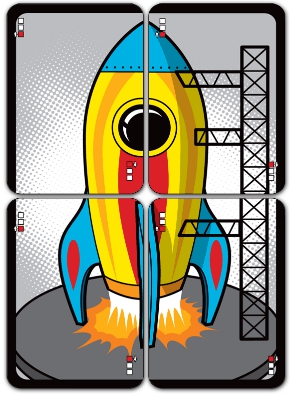
Once the launch pad is completed all the rockets are launched!
Scoring Points
Points are scored using Rocket and Bonus cards, but the card value is based on the card’s current zone. This means those rockets you spent so much time and energy to build might cost you the game if you didn’t also advance them to the Launch Zone.
Note that each Rocket card is worth a number of points (as displayed on the card’s upper right-hand corner. Bonus cards also count as points but only if they are in the Launch Zone with the rocket and meet the requirements to be scored.
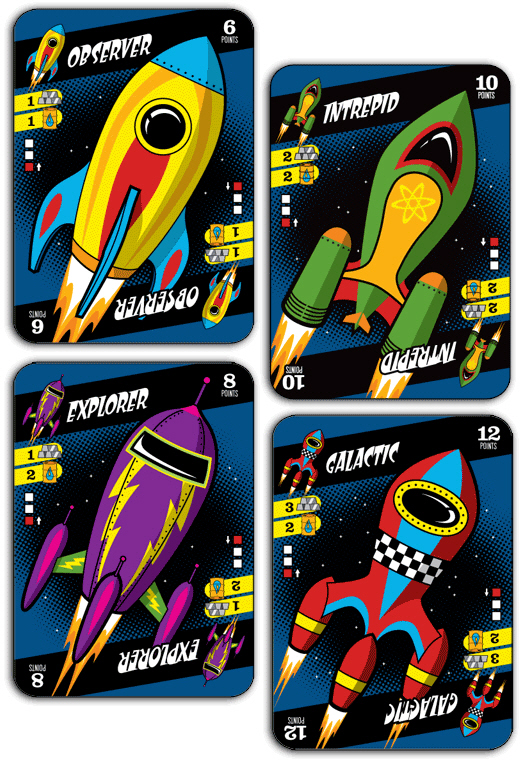
Rockets can either increase or decrease your total score depending on what zone they are in at the end of the game
To determine each player’s final score, a little bit of math is needed. This is rather simple math, however, and should not require a pen and paper to record. I highly suggest you let the little geeks practice their math skills and help them as needed to count up their points.
 Once all the points have been added and subtracted to determine each player’s final score, the player with the highest score wins!
Once all the points have been added and subtracted to determine each player’s final score, the player with the highest score wins!
Game Variants
There are several game variants included that change the length of the game, introduce card trading, and provides unlimited special abilities. They are summarized here.
- Increase or Decrease Game Length: for a faster game, immediately advance a Launch Pad card through the zones once drawn, or for a longer game, remove the Launch Pad cards from the draw deck until the entire deck has been used at least once.
- Negotiations: on a players turns when they play cards, they can trade or donate as many cards as they like with another player. Donated cards cannot be accepted by a player if it causes them to exceed their hand size limit.
- Super Powers: there is no limit to the number of Specialty cards a player can have in play.
The complete rules of Launch Pad can be downloaded from the official game web site. There is also a helpful player’s mat available to help you learn how to play the game.
Prediction
Once again, this game looks to be a hit for my little geeks even before it came out of the box. They danced around me when I brought out the game like it was a box of chocolate. Once they got their initial energy spent, I sat them down and gave the cards to my little geeks to look through. This continues to be an excellent way for me to get the game going. By allowing them to look at the cards themselves, they show more interest and tend to focus on what I am saying much faster.
This game is too complicated for my 4-year-old and I made sure he knew that upfront. I told him he and I would be partners and he should name our rocket company. This greatly pleased him and he started to rattle off a number of names. We decided on “Ninja Rockets”. My oldest little geek’s reading and math skills should allow him to play this game solo with few problems, but I made certain he also knew he should ask me about any cards he didn’t understand. We went through several cards and explained how they worked. He plays Pokemon fairly well and the concept of cards being attached to other cards and special abilities was nothing new. He seemed to grasp the game quickly enough and declared his rocket company’s name was “Mega Rockets”.
While I shuffled the decks and set up the game, I asked each rocket company CEO their thoughts based on what they had learned so far.
“I like it! I like it! Let’s play the game, already!” ~ Liam (age 7)
“Oh, yeah! I’m going to build all the rockets, Daddy!” ~ Nyhus (age 4)
Hard hats on and goggles down! It’s time to build some rockets!
Final Word
An interesting thing happened when we started playing the game. My 4-year-old decided he wanted to play with his brother instead of his Old Man. So, he left my lap, pulled up a chair, and “Ninja Rockets” and “Mega Rockets” merged into one big company under the new title “Mega Ninja Rockets”. This greatly pleased me as I always enjoy seeing my little geeks work together. For the duration of the game, the two brothers worked as a team and worked well.
As expected, my oldest little geek understood the game concept. He attached components and advanced rockets, playing Specialty cards when needed and action cards like a pro. What he did not do well was resource management with his card hand or use much in the way of strategy and tactics. His way of playing with his little brother was to simply build as fast as he could, placing all of his cards down, and pushing forward. This would seem to be the best course of action, but remember that you can only advance one rocket at a time and you only score points on rockets that are in the Launch Zone. In a very short amount of time, my two little geeks had a very large number of rockets out in their game zone, but little was moving forward. Meanwhile, their Sneaky Old Dad was building a smaller number of rockets and slowly moving them up the zones.
About halfway through the game, my oldest little geek recognized his mistake of going all out. His younger brother, on the other hands, pushed for more rockets. They balanced each other as best they could and continued to play the game. I saw improvement as the game continued, but my oldest little geek mentioned several times he thought the game was lost. I told him to play it through and learn from every experience, be it a victory or a defeat. There is always something to be gained. This made him feel better and the two brothers rallied. Their second half of the game was much stronger than the first and I could see they were going to catch up.
Sadly, their moment of serendipity came too late and the game ended before they could move their rockets for scoring. When their final turn came around, they made the best move possible and advanced the rocket worth the most points forward from the Quality Control Zone. The final spread, however, made it very clear that there were a large number of points not earned. They had, however, greatly reduced their number of negative points. I was most pleased with their performance and told them so. I also made it a point to show them all the great things they did in the game and how smart it was to do what they did. This really made them feel good, and despite losing (horribly), they immediately wanted another game.
Subsequent games of Launch Pad have been even more exciting and enjoyable. My oldest little geek has greatly improved and now gives me a run for my money when we play. It is absolutely wonderful to see a young geek mind evolve in front of you and make you work for a victory!
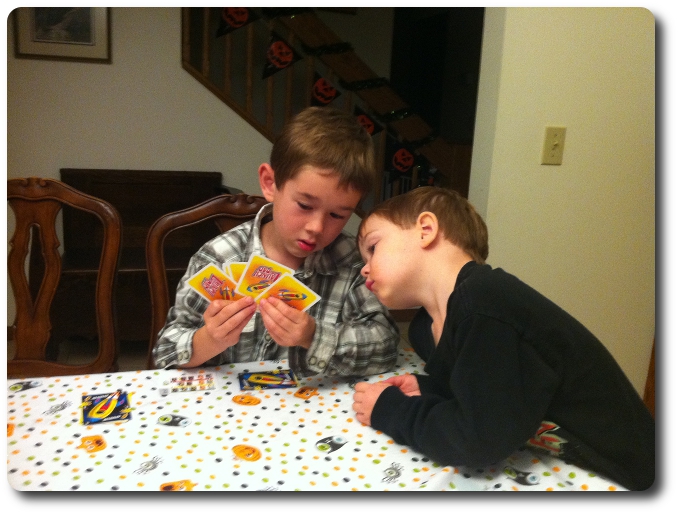
The two little geeks talk strategy while their father looks on, smiling
Gamer Geeks, this is a light strategy card game that is a strange mix of racing and resource management. Your initial instinct will be to build rockets as fast as possible, but you will quickly recognize that the game purposely punishes you for trying to do so. You can build rockets quickly, but you can just as quickly over extend yourself. This makes for an excellent game where you will be balancing your resources while at the same time disrupting your opponent’s progress. The game is fast and light with a surprising level of replay value and opportunity to develop strategy and tactics.
Parent Geeks, this is a fun card game that will keep your family busy at the table and having fun. There is much to do in the game without being overly complicated or heavy. The learning curve is moderate for your little geeks, but this is all dependent on their prior game experience. If they have never played a game like Launch Pad before, do expect to spend time explaining some of the card game’s more subtle rules and card uses. For adults and the non-gamers, this game should be an easy one to pick up and play.
Child Geeks, get ready to build rockets! You get to control everything from manufacturing to launching! It’s a big job but the game goes fast and is a great deal of fun. This game does require you to read the cards, but there is nothing in the game that is terribly complicated. If you ever run into trouble or don’t understand how a card works, just ask your Mom and Dad! After the first game, you’ll be making rockets like a pro!
Launch Pad is an excellent light resource management and race game. There is surprising depth to Launch Pad that was a very pleasant surprise once I recognized it. The game length itself is spot on and allows for game correction and big payoffs if the player correctly calculates their risk vs. reward. The end result is a fantastic card game with a great theme, excellent mechanics, and accessible to all three geek groups. Outstanding!
This game was given to Father Geek as a review copy. Father Geek was not paid, bribed, wined, dined, or threatened in vain hopes of influencing this review. Such is the statuesque and legendary integrity of Father Geek.




Pingback: Father Geek » Mow Money Print-and-Play Game Review
Pingback: Father Geek » Early Peek at DiceAFARI